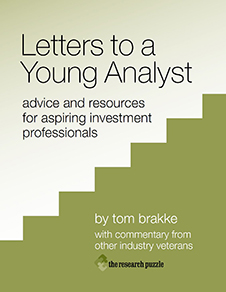
- Thursday, May 28th, 2009
- betting on beta
-
There is much written these days about alpha and beta, with beta cast in the role of cheap market exposure and alpha playing that evasive ability to do better than the market, all statistical things considered, for which we are willing to pay the big bucks. However, our concern today in this continuing series on academic researchthe research puzzle | This PDF shows the series to date (and will be updated as it evolves). is not the beta of one, but the use of one beta to value a security.
As I mentioned in my introductory piece of the series, there are a number of “go to” places to find interesting commentaries on academic research if you don’t want to sift through it on your own. One of the sources I mentioned, CXO Blog, published something recently that caught my eye and serves as a convenient jumping-off point for today’s musings.CXO Advisory Group | Its summary of the two papers referenced is called “The Unreliability of Beta.” A(nother) hat tip to them.
With the bottom-line title of “β = 1 Does a Better Job Than Calculated Betas,” a recent paper by Pablo Fernandez and Vincente Bermejo examines how well beta “works” by examining the performance of the component stocks of the DJIA.SSRN | My reading was of the May 2009 version. The current version of the paper is short and sweet, without the references to prior works or caveats and possibilities that are usually found in academic research. As such, it is probably better suited to practitioners with their (our) famously-short attention spans, rather than academicians, who explore each nuance in great depth and can cite the range of relevant research. Plus, the conclusion plays to the natural skepticism of many practitioners about CAPM, beta, etc.
Of greater interest to me was the companion piece by Fernandez that includes a summary of responses from finance professors around the world about how they use and think about beta.SSRN | It is titled, “Betas Used by Professors: A Survey with 2,500 Answers.” The third section of the paper talks about “the schizophrenic approach to valuation,” in which the estimation of cash flows is known to be uncertain but the discount rate is locked down tight, with beta as the essential driver in relative terms. The comments from the responders seemed to cluster around two points of view: “it’s the best we have” and “all different sorts of investment practitioners and corporate managers use it, so it must be good.” I would dispute both.
The paper includes a standard summary of the shortcomings of regression betas and the possible virtues of alternative approaches, as well as an interesting compilation of quotes from professors about the use and misuse of beta.
As I indicated in the previous posting, I think of valuation as a mapping process, with the valuation “locations” on the map coming from a variety of different calculations, with some coloration to indicate which approaches are likely to be more reliable and which less so. Valuations that result from the range of different potential regressions should be considered, but they should have the color of caution — there are just too many question marks for them to be key navigational tools. Of greater worth prospectively are bottoms-up (or “fundamental” or “qualitative”) approaches, where you have to consider the real risks, not the statistical ones, and arrive at a required rate of return. And, when it comes to the consideration of where prices are today rather than where they will be tomorrow, you can’t ignore the simplistic valuation metrics used widely in the markets.
Another paper, “Sorting Out Downside Beta,”SSRN | This one is by Thierry Post, Pim Van Vliet, and Simon Lansdorp. takes a very long look at returns and concludes that downside beta is better at explaining asset pricing than traditional beta. This seems a fruitful area for further research, given what we know about investor behavior. Many of the articles cited in the bibliography are from years and years ago; it’s time for more work to be done. We could use additional coordinates on that map.
As it stands, if you are betting on beta by making it a linchpin of your valuation work, these papers should at least give you some pause.
